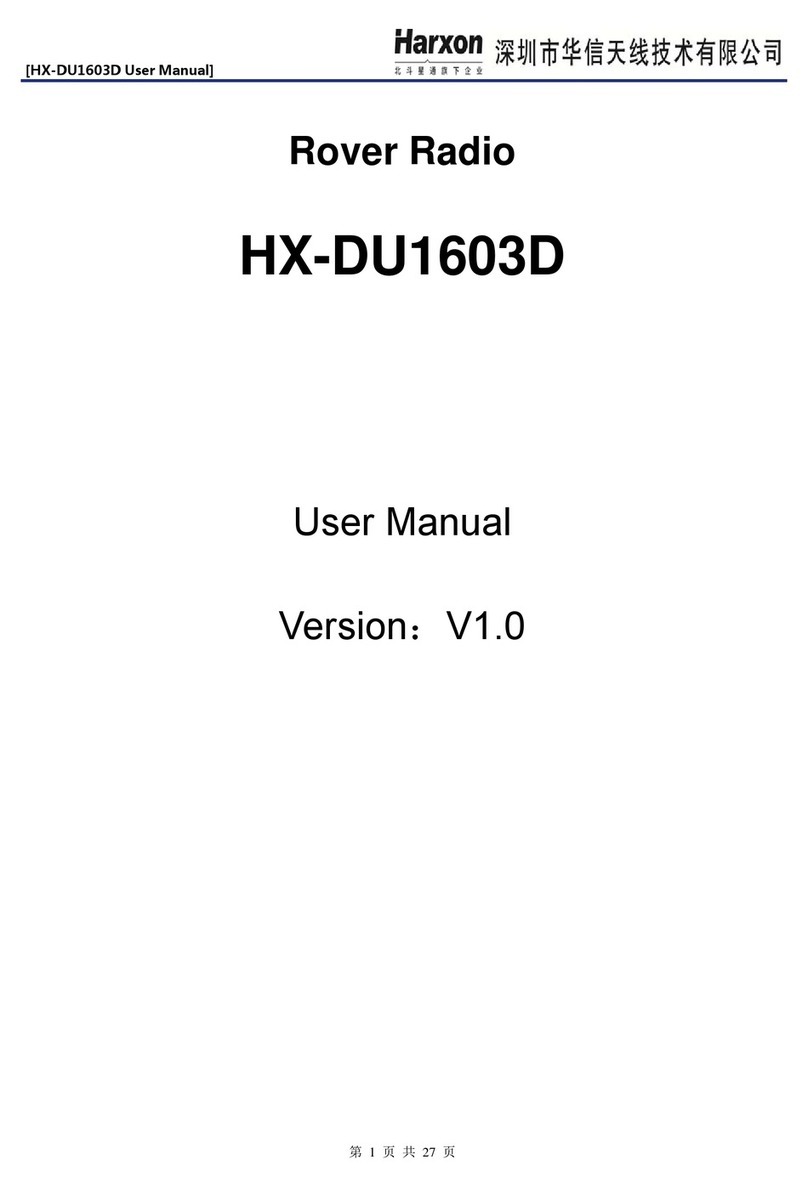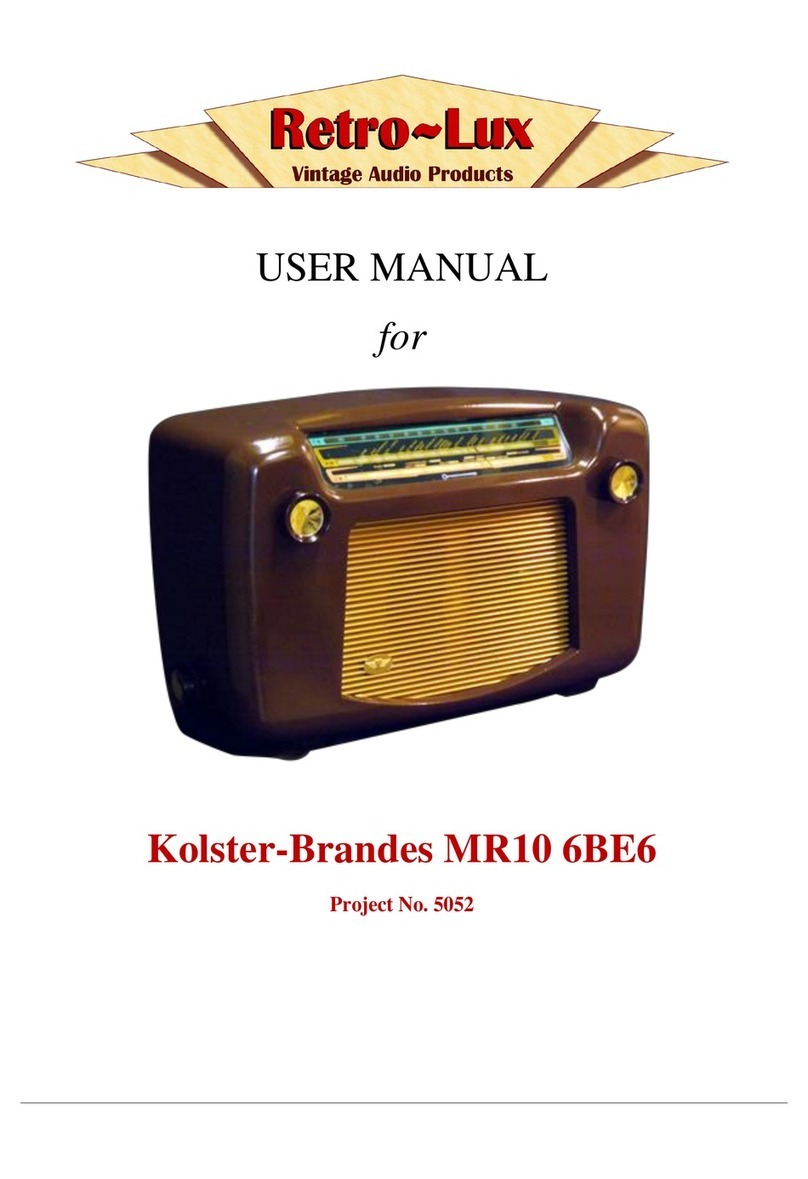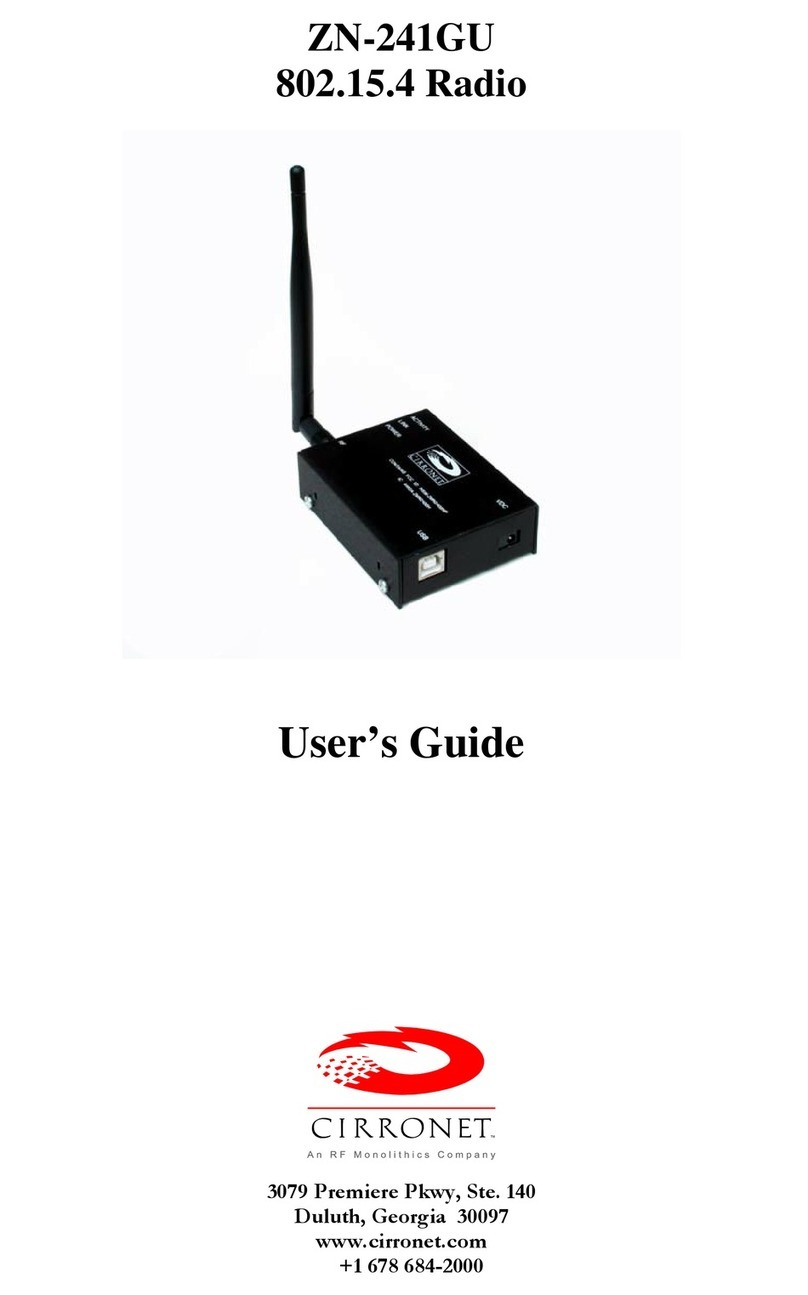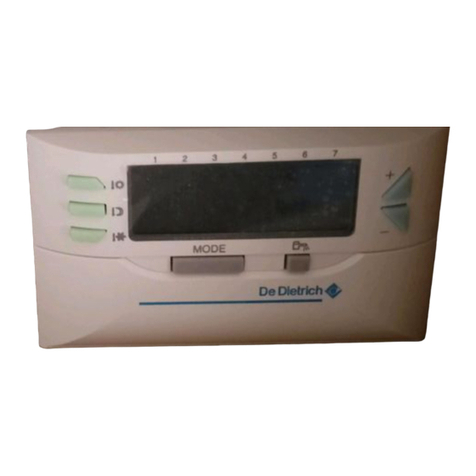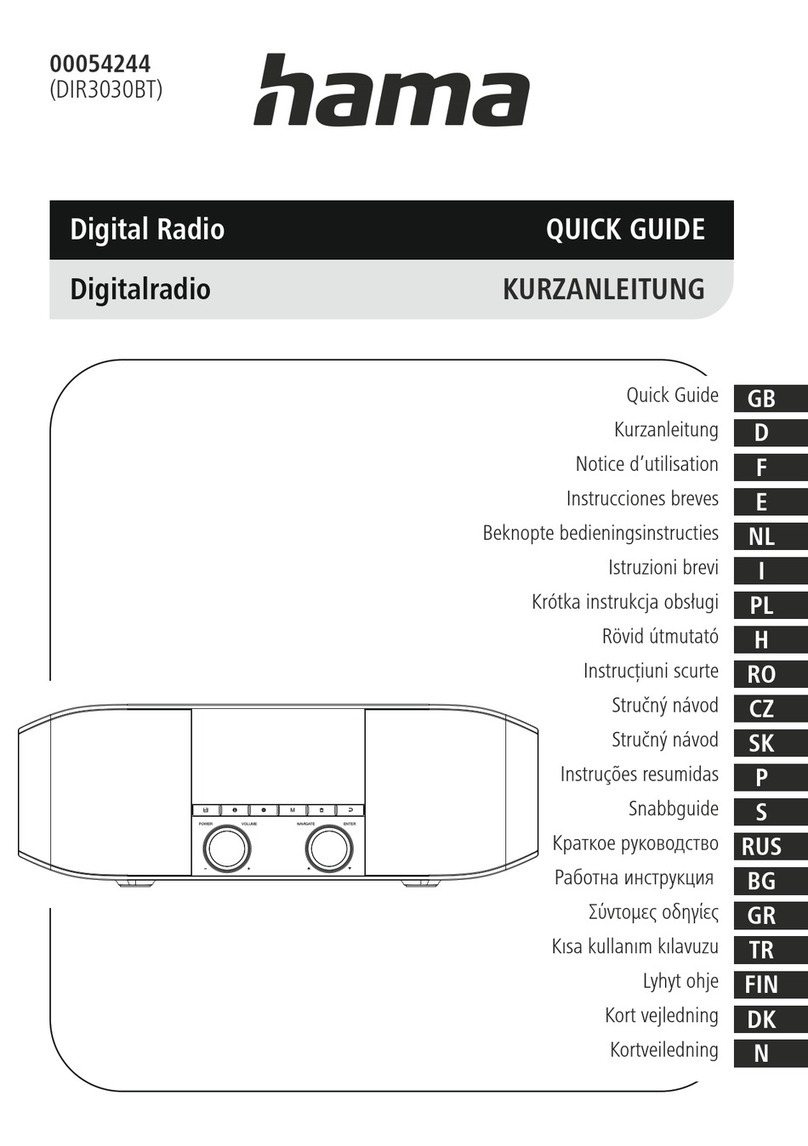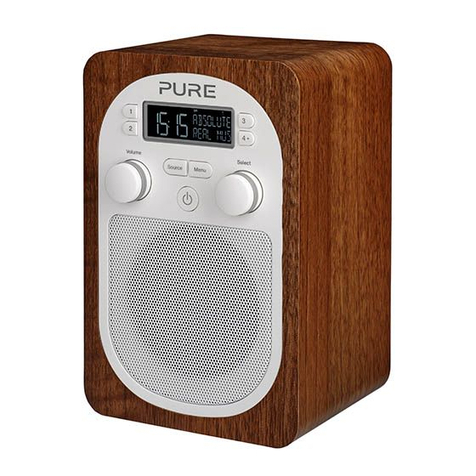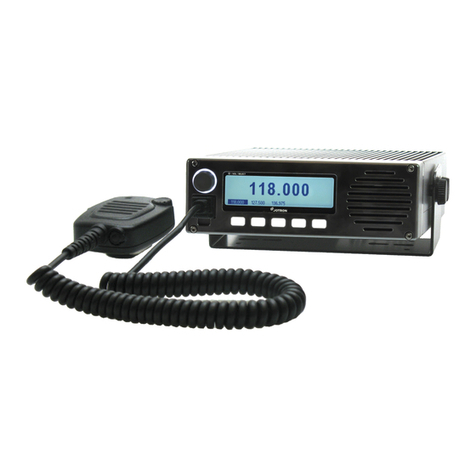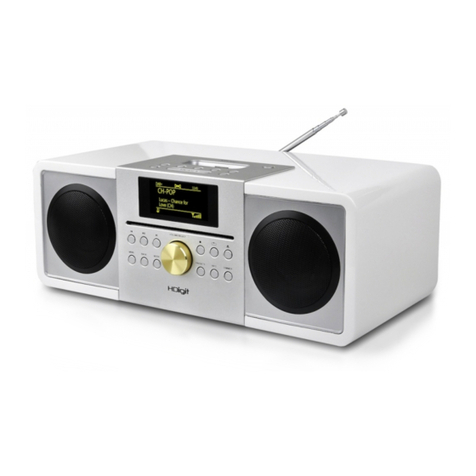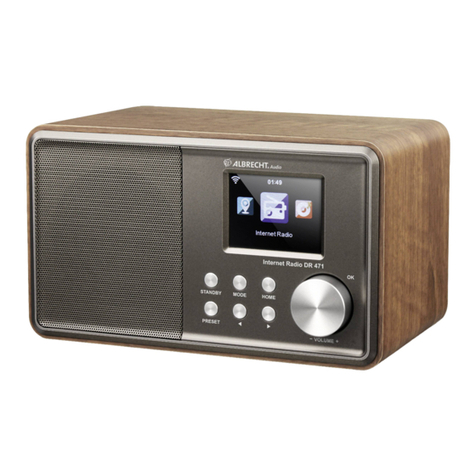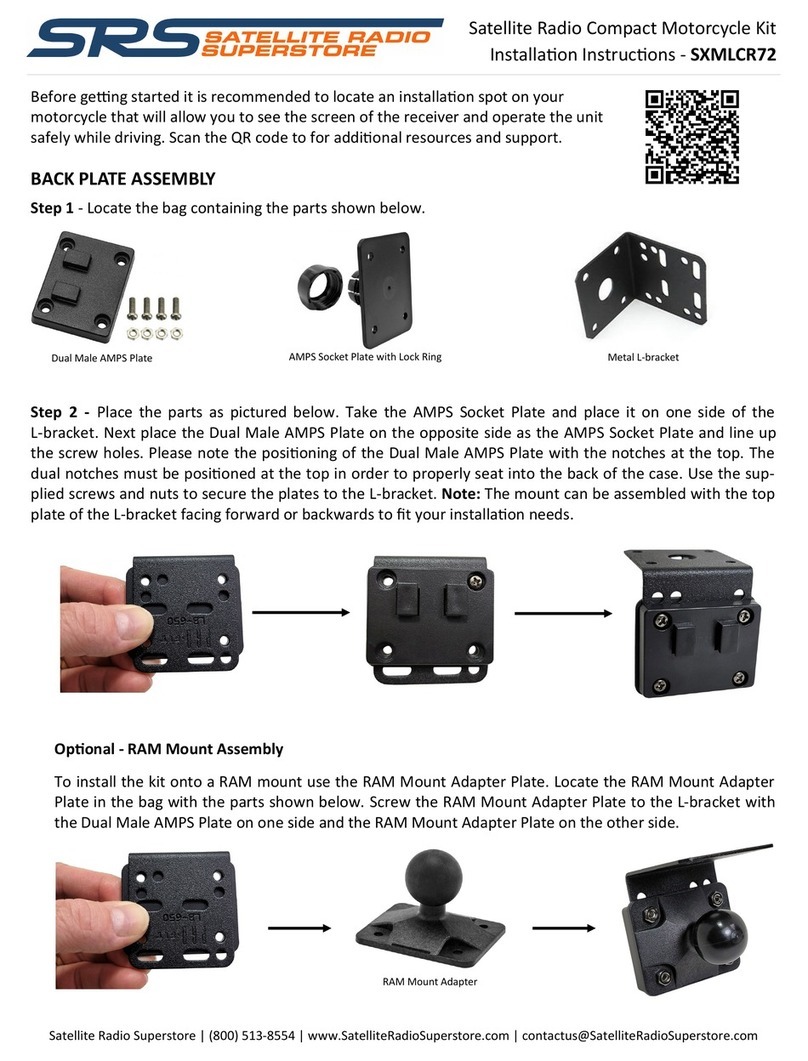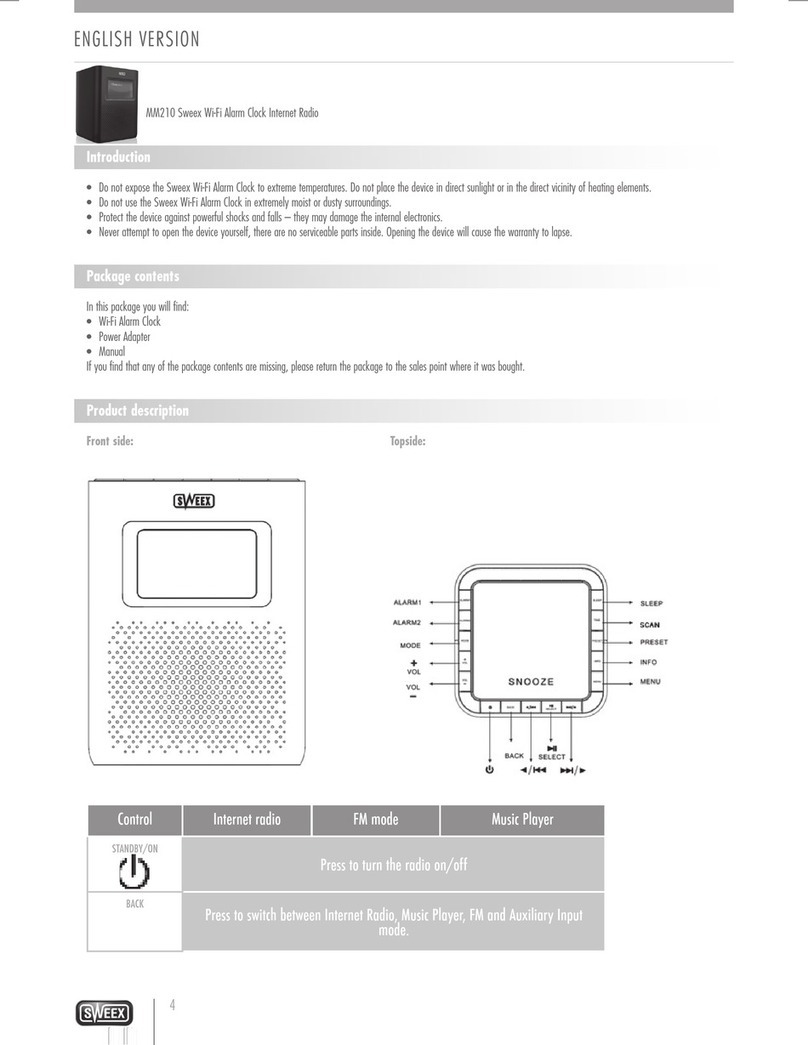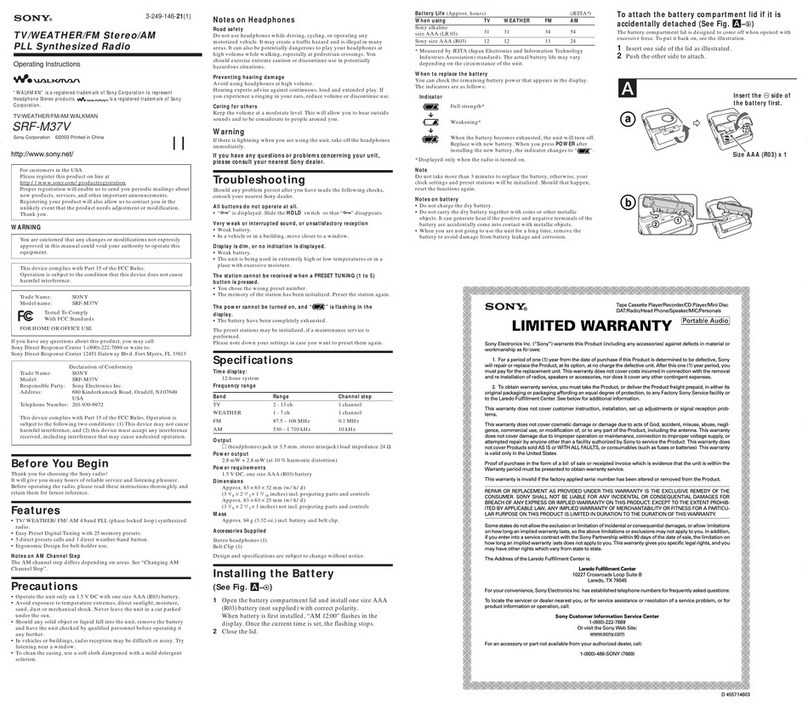Harxon HX-DU2601D-900 User manual

[HX-DU2601D-900 Operating Instructions]
HX-DU2601D-900
Frequency-Hopping Radio
Operating Instructions
Version: V1.0
FCC ID: 2ACRAHX-DU2601D-900
Page 1 of 16

[HX-DU2601D-900 Operating Instructions]
Contents
1PREPARATORY WORK ..................................................................................................................................................3
2OPERATION STEPS ......................................................................................................................................................... 3
2.1 ENVIRONMENT SETUP ................................................................................................................................................... 3
2.2 POWERING UP THE BASEBOARD BY SWITCHING ON THE POWER SUPPLY ......................................................................4
2.3 MODIFYING RADIO PARAMETERS.................................................................................................................................. 4
3APPENDIXES.....................................................................................................................................................................5
3.1 LIST OF AT COMMANDS OF THE RADIO .........................................................................................................................5
3.2 HANDLING OF ABNORMALITIES................................................................................................................................... 10
3.3 PPCOMMUNICATION EXAMPLE OF THE FREQUENCY-HOPPING RADIO......................................................................... 11
3.4 PMPCOMMUNICATION EXAMPLE OF THE FREQUENCY-HOPPING RADIO ..................................................................... 12
4UPDATE OF THE BUILT-IN RADIO............................................................................................................................ 13
Page 2 of 16

[HX-DU2601D-900 Operating Instructions]
1Preparatory Work
DC power supply (two units, with the maximum current of 2A), power line (two pieces), serial port line or
USB-to-serial port line (two pieces), computer (one unit), and serial port debugging assistant (sscom32);
2Operation Steps
2.1 Environment Setup
First, connect the power line of the baseboard, with supply voltage 8-30 V(the supply voltage is usually chosen to
be 12 V). Then, set the configuration switch to the VCC terminal (left). Next, connect the baseboard to the
computer with RS232 DB9 serial port line or USB-to-serial port line (Special notes: Connect the baseboard to
the computer through RS232 data port; this port has a level of 232 rather than TTLlevel). Open the serial
port debugging assistant (sscom32), select the serial port number, and configure the baud rate of the serial port to
be 115200, and correctly install the radio module antenna (frequency band: 902.6M-927.8M), as shown in the
figure below:
DC power supply
Power indicator light
RS232 (Data port)
RSSI indicator light
Receiving LED
Antenna interface
Sending
LED
Configuration switch
Page 3 of 16

[HX-DU2601D-900 Operating Instructions]
2.2 Powering Up the Baseboard by Switching on the Power Supply
After the power supply is switched on, the power indicator light is on. In the operating mode of the master
radio, LED TX indicator light flickers once two seconds on a PP (point to point) basis, and constantly flickers on
a PMP (point to multipoint) basis. In the operating mode of the slave radio, RSSI indicator light flickers like a
waterfall light before the synchronization of the master and the slave. Such RSSI indicator light stops flickering
when this synchronization is completed. This synchronization is indispensable for transmission of user data.
As data is sent, TX LED red indicator light illuminates; as data is received, RX LED green indicator light
illuminates (Remarks: The red indicator light replaces the green one temporarily since the latter does not
have enough luminance).
2.3 Modifying Radio Parameters
(1) First, set the configuration switch to the right (close to the silk-screen GND terminal) or send the character
string "+++" (pay attention to the sending method: Within one second before sending "+++", make sure that
no data is available; within one second after sending "+++", make sure that no data is available; no codes of
carriage returns and line feeds follow such character string sent), namely, the radio goes into the parameter
configuration mode (showing "NO CARRIER OK");
(2) Then, input the parameter modification command (see Appendix I "List of AT Commands of the Radio");
(3) After modifying a parameter, input the parameter saving command (AT&W); otherwise, that parameter is
not saved in the case of power failure;
(4) Finally, set the configuration switch to the left (silk-screen VCC terminal) or run the command ATA,
namely, allow the radio to work in a normal mode (other than AT command configuration state);
(5) Restart the radio.
Notes: (1) Any AT commands must be followed by carriage returns and line feeds (In the serial
port assistant tools, choose "Send the New Line". Sending the new line indicates that software
automatically adds two characters of carriage returns and line feeds); (2) if the current
configuration pin is grounded, sending "+++" and running the ATA command are invalid.
Page 4 of 16

[HX-DU2601D-900 Operating Instructions]
3Appendixes
3.1 List ofAT Commands of the Radio
Format of the AT command
Format of the parameter configuration command: ATS + register number = value + carriage return and line
feed; for example,ATS103=7
Format of the parameter query command: ATS + register number?+ carriage return and line feed; for
example, ATS103?
Remarks:
(1) After modifying the parameter by the AT command, surely save this parameter by the AT&W command;
(2) Black bold font indicates the ex-work default value;
(3) AT commands without special instructions apply to both the narrow band mode and the frequency-hopping
mode.
The first category of commands: specialAT commands
(1) Parameter saving command
Send the command: AT&W+ carriage return and line feed
Set successful return to "OK".
Notes: If a user modifies the radio parameter, and desires to save it upon power failure, he must send the
parameter saving commandAT&W upon modification. Otherwise, such parameter will become missing
upon power failure.
(2) Display of the current working parameters of the radio
Send the command: AT&V+ carriage return and line feed
Set successful return to "OK".
After this command is executed, most parameters of the radio appear; for example:
Page 5 of 16

[HX-DU2601D-900 Operating Instructions]
(3) Display of the current address list of the slave
Send the command: ATT?+ carriage return and line feed
The currently supported address information of the slave is displayed, for example:
Address
Sequence
number
(4) Configuration of the address list of the slave
Send the command: ATTn=xxx+ carriage return and line feed
Configure the slave address of the currently designated sequence;
For example,ATT0 = 120, denoting that the slave address with the sequence number being 0 is 120.
Remarks: (1) Range of sequence numbers: 0-254. Range of slave addresses: 0-254. If the address is
configured to be 0, this indicates the deletion of the current slave node. (2) When the radio address is 255, no
address configuration is required. (3) This configuration command applies to the PMP master mode (the
address configuration does not help configure the slave address list from the slave mode terminal), but is not
appropriate for other modes. (4) You can query the slave address of the corresponding sequence number by
the command ATTn?;
The second category of commands: configuration of commonAT commands
(1) Modification of the operating mode
Send the command: ATS101=value+ carriage return and line feed
Set successful return to "OK".
Values are as follows:
0- denote the master.
1- denote the relay(not supported temporarily)
2- denote the slave.
Set successful return to "OK".
(2) Modification of the baud rate of serial port
Send the command: ATS102=value+ carriage return and line feed
Set successful return to "OK".
Values(bps) are as follows:
1-115200; 2-57600; 3-38400; 4-28800; 5-19200; 6-14400; 7-9600;
Page 6 of 16

[HX-DU2601D-900 Operating Instructions]
For example, ATS102=1, denoting that the serial port of the current radio has a communication baud rate of
115,200 bps.
(3) Modification of the RF baud rate
Send the command: ATS103=value+ carriage return and line feed
Set successful return to "OK".
1) In the frequency-hopping mode
Values(bps) are as follows:
0-19200,1-115200;2-172800;3-230000;7-38400;8-57600;
2) In the narrow band mode
Values(bps) are as follows:
0-4800; 1-8000; 2-9600; 3-16000; 4-19200;
(4) Modification of network ID (frequency-hopping mode)
Send the command: ATS104=value+ carriage return and line feed
Set successful return to "OK".
Range of values: 0-255. The valid value of network ID is related to the number N of frequency-hopping
channels. 900M-FH:N=64; 400M-FH:N=64; 840M-FH:N=16; 869M-FH:N=8. When the network ID value
is greater than or equal to N, the actual network ID is the modulovalue of N.
(5) Modification of the local address
Send the command: ATS105=value+ carriage return and line feed
Set successful return to "OK".
Range of values: 1-254
Remarks: The radio address is 255; the local address is, by default, configured to be 1 in the master mode,
and be 2 in the slave mode.
(6) Modification of the transmitting power
Send the command: ATS108=value+ carriage return and line feed
Set successful return to "OK".
Values are as follows:
H: 1W, M:1W, L:0.5W
Remarks: Only 840M and 869M support 2W, others support 1W at most.
(7) Modification of frequency-hopping interval (frequency-hopping mode)
Send the command: ATS109=value+ carriage return and line feed
Page 7 of 16

[HX-DU2601D-900 Operating Instructions]
Set successful return to "OK".
Values(ms) are as follows:
1-20ms; 2-30ms; 3-40ms; 4-50ms;
For example, ATS109=1, denoting that the radio changes the frequency point once every 20 MS.
(8) Query of frequency band range (this command supports query only)
Send the command: ATS128?+ carriage return and line feed
Set successful return to "OK".
Values are as follows:
1-900MHz Frequency Hopping (FH);
2-400MHz Frequency Hopping (FH);
3-840MHz Frequency Hopping (FH);
4-865MHz Frequency Hopping (FH);
(9) Modification of frequency band range
Send the command: CMD=HX+ carriage return and line feed
Set successful return to "PROGRAMMED OK".
Send the command: modem value + carriage return and line feed (Pay attention to one blank space after the
modem, for example, modem 1)
Set successful return to "PROGRAMMED OK".
Send the command: CMD MH+ carriage return and line feed
Set successful return to "OK".
Values are as follows:
1-900MHz Frequency Hopping (FH);
2-400MHz Frequency Hopping (FH);
3-840MHz Frequency Hopping (FH);
4-865MHz Frequency Hopping (FH);
(10) Network mode (frequency-hopping mode)
Send the command: ATS133=value+ carriage return and line feed
Set successful return to "OK".
Values are as follows:
Page 8 of 16

[HX-DU2601D-900 Operating Instructions]
0-Point to Multipoint (PMP);
1-Point to point (PP);
(11) Modification of the destination address
Send the command: ATS140=value+ carriage return and line feed
Set successful return to "OK".
Range of values: 1-255
Remarks: The radio address is 255; the local address is, by default, configured to be 1 in the master mode,
and be 2 in the slave mode.
The third category of commands: configuration ofAT commands to restore the ex-work default value in
various modes
1. AT&F1 (frequency-hopping mode)
High speed mode of the master on a PMP basis (Link rate=115200bps, Serial rate=115200), default
parameter configuration
2. AT&F2 (frequency-hopping mode)
High speed mode of the slave on a PMP basis (Link rate=115200bps, Serial rate=115200), default parameter
configuration
3. AT&F4 (frequency-hopping mode)
Low speed mode of the master on a PMP basis (Link rate=38400bps, Serial rate=115200), default parameter
configuration
4. AT&F5 (frequency-hopping mode)
Low speed mode of the slave on a PMP basis (Link rate=38400bps, Serial rate=115200), default parameter
configuration
5. AT&F6 (frequency-hopping mode)
High speed mode of the master on a PP basis (Link rate=115200bps, Serial rate=115200), default parameter
configuration
6. AT&F7 (frequency-hopping mode)
High speed mode of the slave on a PP basis (Link rate=115200bps, Serial rate=115200), default parameter
configuration
7. AT&F8 (frequency-hopping mode)
Low speed mode of the master on a PP basis (Link rate=38400bps, Serial rate=115200), default parameter
configuration
8. AT&F9 (frequency-hopping mode)
Low speed mode of the slave on a PP basis (Link rate=38400bps, Serial rate=115200), default parameter
configuration
Page 9 of 16

[HX-DU2601D-900 Operating Instructions]
3.2 Handling of Abnormalities
(1) The master and the slave fail to implement synchronization.
1) Fail to set the configuration switch to the left;
2) The antenna interface has poor contact;
3) The power supply has limited current or too small power;
4) It is recommended to power up the radio again from the configuration mode to the data mode.
(2) Failure to receive or send data
1) The baud rate of serial port is 115200 (8 data bits, stop bit: 1, without odd-even check);
2) The serial port tool have poor contact (if the USB-to-serial port is used, check whether the driver of the
USB-to-serial port is set up);
3) The serial port number is not correctly selected (ports No.1-9 are recommended);
(3) Attached figure of the serial port tool
Page 10 of 16

[HX-DU2601D-900 Operating Instructions]
3.3 PP Communication Example of the Frequency-hopping Radio
In the configuration mode (set the
configuration switch to the silk-screen
GND terminal), take turns to input the
following commands: AT&F6, AT&W.
Finally, quit the configuration mode (set the
configuration switch to the silk-screen
VCC terminal).
Remarks: The current terminal works in the
master mode. The serial port has a baud rate
of 115200. The RF baud rate is 115200. The
power is high. The communication is
full-duplex.
In the configuration mode (set the
configuration switch to the silk-screen
GND terminal), take turns to input the
following commands: AT&F7, AT&W.
Finally, quit the configuration mode (set
the configuration switch to the
silk-screen VCC terminal).
Remarks: The current terminal works in
the slave mode. The serial port has a
baud rate of 115200. The RF baud rate is
115200. The power is high. The
communication is full-duplex.
Terminal A
Terminal B
Page 11 of 16

[HX-DU2601D-900 Operating Instructions]
3.4 PMP Communication Example of the Frequency-hopping Radio
In the configuration mode (set the configuration switch to
the silk-screen GND terminal), take turns to input the
following commands:
(1) AT&F4, (2) ATT0=2, (3) ATT1=3, (4) ATT2=4, (5)
AT&W. Finally, quit the configuration mode (set the
configuration to the silk-screen VCC terminal).
Remarks:
(1) The current terminal works in the master mode.
(2) The serial port has a baud rate of 115200 in the
low-power mode.
(3) The RF baud rate is 38400.
(4) Network ID is 1234567890.
(5) Local address is 1.
(6) The slave addresses supported by the current master
are 0x02, 0x03 and 0x04.
In the configuration mode (set the configuration
switch to the silk-screen GND terminal), take
turns to input the following commands:
AT&F5, AT&W. Finally, quit the configuration
mode (set the configuration to the silk-screen
VCC terminal).
Remarks:
(1) The current terminal works in the slave
mode.
(2) The serial port has a baud rate of 115200 in
the low-power mode.
(3) The RF baud rate is 38400.
(4) Network ID is 1234567890.
(5) Local address is 2.
Terminal A
Terminal B
In the configuration mode (set the configuration
switch to the silk-screen GND terminal), take
turns to input the following commands:
AT&F5, ATS105=3, AT&W. Finally, quit the
configuration mode (set the configuration to the
silk-screen VCC terminal).
Remarks:
(1) The current terminal works in the slave
mode.
(2) The serial port has a baud rate of 115200 in
the low-power mode.
(3) The RF baud rate is 38400.
(4) Network ID is 1234567890.
(5) Local address is 3.
In the configuration mode (set the configuration
switch to the silk-screen GND terminal), take
turns to input the following commands:
AT&F5, ATS105=4, AT&W.Finally, quit the
configuration mode (set the configuration to the
silk-screen VCC terminal).
Remarks:
(1) The current terminal works in the slave
mode.
(2) The serial port has a baud rate of 115200 in
the low-power mode.
(3) The RF baud rate is 38400.
(4) Network ID is 1234567890.
(5) Local address is 4.
Terminal C
Terminal D
Page 12 of 16

[HX-DU2601D-900 Operating Instructions]
4Update of the Built-in Radio
1. First, connect the radio to the PC with a serial port line. Select 9 V or 12 V as the supply voltage of the DC
terminal.
Notes: "RS232 interface" is based on the 232 level rather than TTL level. Use the USB-to-serial port line or
RS 232 serial port line to connect the PC device.
2. Find the update tool , and open this software:
3. Select the right serial port number and baud rate, open the serial port, and select the built-in radio.
Remarks: The serial port number selected is smaller than 10; here, the baud rate of serial port
is the communication baud rate of the serial port of the current radio, which is 115200 by
default (the specific baud rate is subject to the actual situation). 115200 is recommended to
update the radio.
Page 13 of 16

[HX-DU2601D-900 Operating Instructions]
4. Select the file to be updated (for example, HX-DUA022.00.01F.dwn)
5. Click the Start button (When you click the Start button, a prompt box pops up to display "Verify the serial
parameter correctly?". In this case, you should click OK. After that, the system immediately starts updating).
Page 14 of 16

[HX-DU2601D-900 Operating Instructions]
6. The update is followed by a prompt showing "Firmware update success!" Then, click OK, and thus
complete the current update.
Page 15 of 16

[HX-DU2601D-900 Operating Instructions]
Manual Information To the End User
The OEM integrator has to be aware not to provide information to the end user
regarding how to install or remove this RF module in the user’s manual of the
end product which integrates this module.
The distance of module for mobile device use must be more than 20cm from user.
OEM installation only, not sold to general end users.
Users only can use approved antenna type.
antenna type: whip antenna
antenna gain: 2dBi
OEM can integrate this module into the whole machine through the serial port.
Page 16 of 16
Table of contents
Other Harxon Radio manuals
